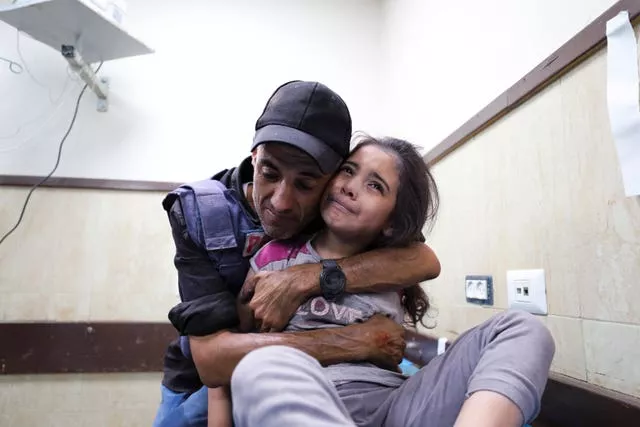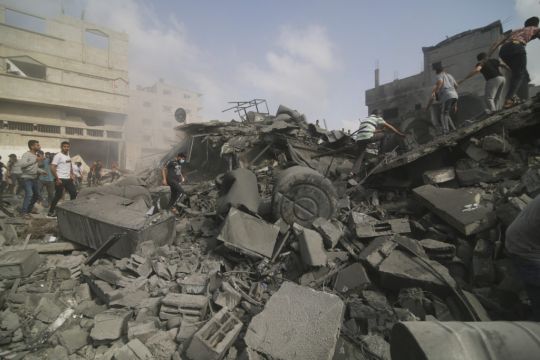Israeli warplanes have struck targets across Gaza on Saturday and Sunday, as well as two airports in Syria and a mosque in the occupied West Bank allegedly used by militants, as the war with Hamas threatened to spiral into a broader conflict.
Israel has traded fire with Lebanon’s Hezbollah militant group on a near-daily basis since the war began, and tensions are soaring in the Israeli-occupied West Bank, where Israeli forces have battled militants in refugee camps and carried out two air strikes in recent days.
Israeli Prime Minister Benjamin Netanyahu told troops in northern Israel that if Hezbollah launches a war against Israel, “it will make the mistake of its life. We will cripple it with a force it cannot even imagine and the consequences for it and the Lebanese state will be devastating”.
For days, Israel has seemed to be on the verge of launching a ground offensive in Gaza as part of its response to Hamas’ deadly October 7 rampage.

Tanks and tens of thousands of troops have massed at the border, and Israeli leaders have spoken of an undefined “next stage” in operations.
Israel’s military spokesman, Rear Admiral Daniel Hagari, said the country had increased air strikes across Gaza to hit targets that would reduce the risk to troops in the next stage of the war.
Hamas said it fought with Israeli forces near Khan Younis in southern Gaza and destroyed a tank and two bulldozers. The Israeli military said it had no information about the claim.
Late on Sunday, Rear Admiral Hagari announced that a soldier was killed and three others wounded by an anti-tank missile during a raid inside Gaza as part of efforts to rescue more than 200 hostages abducted in the October 7 attack.
On Saturday, 20 trucks entered Gaza in the first aid shipment into the territory since Israel imposed a complete siege two weeks ago.
Israeli authorities said late on Sunday they had allowed a second batch of aid into Gaza at the request of the United States.
COGAT, the Israeli defence body responsible for Palestinian civilian affairs, said the aid included water, food and medical supplies and that everything was inspected by Israel before it was brought into Gaza.
UNRWA, the UN agency for Palestinian refugees, confirmed the arrival of 14 trucks.
Israel has not allowed any fuel to enter Gaza.
Earlier Associated Press journalists saw seven fuel trucks head north from the border.
But the United Nations and Israel said those trucks were taking fuel stored on the Gaza side of the crossing deeper into the territory, and that no fuel had entered from Egypt.
The volume of goods that entered #Gaza on Saturday is only a fraction of what is needed after days of complete siege. @UNReliefChief urges an increase in aid access to at least 100 trucks a day.
More in our latest update: https://t.co/320eJIYSYw pic.twitter.com/ON4Z9lmpVg— UN Humanitarian (@UNOCHA) October 22, 2023
In a sign of how precarious any movement of aid remains, the Egyptian military said in a statement that Israeli shelling hit a watchtower on Egypt’s side of the border, causing light injuries.
The Israeli military apologised, saying a tank had accidentally fired and hit an Egyptian post, and the incident was being investigated.
Relief workers said far more was needed to address the spiralling humanitarian crisis in Gaza, where half the territory’s 2.3 million people have fled their homes.
The UN humanitarian agency (OCHA) said Saturday’s convoy carried about 4% of an average day’s imports before the war and “a fraction of what is needed after 13 days of complete siege”.
The Israeli military said the humanitarian situation was “under control”, as the OCHA called for 100 trucks a day to enter.
Israel repeated its calls for people to leave northern Gaza, including by dropping leaflets from the air.
It says an estimated 700,000 have already fled, but hundreds of thousands remain. That would raise the risk of mass civilian casualties in any ground offensive.

Israeli military officials say Hamas’s infrastructure and underground tunnel system are concentrated in Gaza City, in the north, and that the next stage of the offensive will include unprecedented force there.
Israel says it wants to crush Hamas, but officials have also spoken of carving out a possible buffer zone to keep Palestinians from approaching the border.
Hospitals packed with patients and displaced people are running low on medical supplies and fuel for generators, forcing doctors to perform surgeries with sewing needles, using vinegar as disinfectant, and without anaesthesia.
The World Health Organisation (WHO) says at least 130 premature babies are at “grave risk” because of a shortage of generator fuel.
The IDF & ISA just conducted an aerial strike on a Hamas and Islamic Jihad terrorist compound in the Al-Ansar Mosque in Jenin.
Recent IDF intel revealed that the Mosque was used as a command center to plan and execute terrorist attacks against civilians. pic.twitter.com/gQfyv6wUAV— Israel Defense Forces (@IDF) October 22, 2023
It said seven hospitals in northern Gaza have been forced to shut down due to damage from strikes, lack of power and supplies, or Israeli evacuation orders.
Shortages in critical supplies, including ventilators, are forcing doctors to ration treatment, said Dr Mohammed Qandeel, who works in Khan Younis’ Nasser Hospital. Dozens of patients continue to arrive and are treated in crowded, darkened corridors, as hospitals preserve electricity for intensive care units.
“It’s heartbreaking,” Dr Qandeel told the AP. “Every day, if we receive 10 severely injured patients we have to manage with maybe three or five ICU beds available.”
Palestinians sheltering in UN-run schools and tent camps are running low on food and drinking dirty water. A power blackout has crippled water and sanitation systems. The OCHA said cases of chickenpox, scabies and diarrhoea are on the rise because of the lack of clean water.

Heavy air strikes were reported across Gaza, including in the southern part of the coastal strip, where Israel has told civilians to seek refuge.
At the Al-Aqsa hospital in Deir al-Balah, south of the evacuation line, several bodies wrapped in white shrouds were lined up outside on the ground.
Khalil al-Degran, a hospital official, said more than 90 bodies had been brought in since early on Sunday, as the sound of nearby bombing echoed behind him. He said 180 wounded people had arrived, mostly children, women and the elderly who had been displaced from other areas.
Israel’s military has said it is striking Hamas members and installations, but does not target civilians. Palestinian militants have fired over 7,000 rockets at Israel, according to the military, and Hamas says it targeted Tel Aviv early Sunday.

The military said it plans to step up air strikes ahead of the “next stages of the war”, without elaborating.
More than 1,400 people in Israel have been killed in the war – mostly civilians who died during the initial Hamas attack. At least 212 people were captured and dragged back to Gaza, including men, women, children and older adults. Two Americans were released on Friday in what Hamas said was a humanitarian gesture.
More than 4,600 people have been killed in Gaza, according to the Hamas-run health ministry. That includes the disputed toll from a hospital explosion.
US secretary of state Antony Blinken told CBS’s Face The Nation that Hamas was responsible, not just for its brutal rampage in southern Israel, but for the deaths of civilians in Israel’s attacks on Gaza.
“It knew that in Israel’s necessary response, civilians would be caught in that crossfire,” he said.
Mr Blinken said the militants were operating among the civilian population and its tunnels were buried under hospitals and schools.
“What does anyone expect Israel to do?” he said.
“This is on Hamas.”
Syrian state media meanwhile reported that Israeli air strikes have targeted the international airports in the capital, Damascus, and the northern city of Aleppo.
The first UN supplies of water, food and medicine have entered Gaza.
To save children's lives, much more is needed.
We continue to call for a ceasefire to protect civilians and humanitarian workers, and ensure safe and sustained access to aid. pic.twitter.com/9s0KfefYsE— UNICEF (@UNICEF) October 21, 2023
The strikes killed one person and damaged the runways, putting them out of service, media reported.
Israel has carried out several strikes in Syria, including on the airports, since the war began. Israel rarely acknowledges individual strikes, but says it acted to prevent Hezbollah and other militant groups from bringing in arms from their patron, Iran, which also supports Hamas.
In Lebanon, Hezbollah said six of its fighters were killed Saturday, and the group’s deputy leader, Sheikh Naim Kassem, warned that Israel would pay a high price if it starts a ground offensive in Gaza.
Hezbollah targets were hit on Sunday in response to rocket fire, the military said.
Israel also announced evacuation plans for another 14 communities near the Lebanon border. Kiryat Shmona’s 20,000 people were told to evacuate last week.
In the Israeli-occupied West Bank, 93 Palestinians have been killed – including eight on Sunday – in clashes with Israeli troops, arrest raids and attacks by Jewish settlers since the Hamas attacks, according to the Palestinian Health Ministry.
Israeli forces have closed crossings into the territory and checkpoints between cities, measures they say are aimed at preventing attacks. Israel says it has arrested more than 700 Palestinians since October 7, including 480 suspected Hamas members.
Israeli forces killed at least five people there early on Sunday, according to the health ministry.







